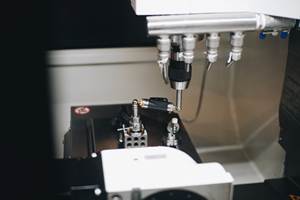Sensitive and Strong: Advanced Digital Comparators
Borrowing from cell phone touchscreen technology, user interfaces on industrial gages are increasingly sensitive — and strong.
Share






Advances in metrology have led to unique user interfaces that are controlled by touch — even with gloves on. Image: Mahr
The metrology industry is constantly changing. Microelectronics and PCs have changed the way measurements are made and how data is used to improve and document processes. However, other than new sensor technologies that have been developed, most user interface technologies for measuring systems are borrowed from other fields. There are probably no more dynamic industries over the past few decades than the world of user interfaces developed for cell phones, tablets and PCs. Through advances in these industries, we have seen products go wireless, and dedicated switches and keyboards have moved to touch screens as the primary user interface.
We have all had experience dropping our cell phones and gasping as they tumble out of our hands. But more often than not, with a quick wipe, it’s good for another day. This is where the metrology industry is borrowing from the technology in today’s smartphones. Just as many smartphones are made from glass, a new generation of digital comparators follow the same path.
As scary as it sounds, putting a glass indicator on the shop floor is actually a good idea. The newest glass technology in phones and tablets is extremely tough. Maybe dropping them is not a good idea, but under normal use, one can get a lifetime of button pushes on a glass screen without degrading performance.
No buttons also mean fewer areas for contamination. And because the button labeling is under the glass face, there is no chance for the labeling of the button to wear off. We all know that re-zeroing is often recommended, and it is not uncommon to use a dynamic reset button for every measurement. Thus, typical switches in a digital indicator can take a beating. Even the painted or stamped markings associated with the push button can eventually rub off or be removed by solvents used at the workstation. But with a touch-sensitive screen, the new technology means longer life and better sensitivity on the shop floor.
However, the more significant improvement could be the ease of use, even when the operator is wearing gloves at the point of manufacture. Certain glass screens do not need an actual finger touch but can be switched or selected while wearing gloves, even in the harshest conditions, but are still sensitive enough that resetting zero does not create sufficient force to deform the measurement set up and create an undetected bias during the zeroing process.
In many ways, digital indicators are becoming so powerful that they are taking on the performance and features once found in PC-based gaging systems. It is not uncommon to find features such as dynamic measurements, multiplication factors, unilateral tolerances, different output formats and sub-micron resolutions in higher-end digital indicators. If there was a weakness in digital indicators, it usually came from the accuracy side. This is because most longer-range digital indicators are built upon scale technology, which is great for most of the applications found around the shop. But when it comes to parts with extremely tight tolerances, there is no match for an LVDT-based bench amplifier system or an LVDT-based digital comparator.
LVDT technology has long been known for its extreme accuracy, repeatability and long life in the manufacturing environment. Again, borrowing from new battery technology and power management found in cell phones and tablets, this power-hungry technology can be built into digital comparators with long battery life that can run a month before requiring a charge.
The combination of an LVDT-based transducer built into the display of a digital indicator offers a much less expensive solution to a PC or bench amplifier system. It makes for a high-performance upgrade of dial or digital indicators in bench stands.
This combination has the sensitivity needed for high accuracy and extreme trouble-free life in the toughest environments.
Related Content
4 Ways to Establish Machine Accuracy
Understanding all the things that contribute to a machine’s full potential accuracy will inform what to prioritize when fine-tuning the machine.
Read MoreThe Link Between CNC Process Control and Powertrain Warranties
Ever since inventing the touch-trigger probe in 1972, Sir David McMurtry and his company Renishaw have been focused on achieving process control over its own manufacturing operations. That journey has had sweeping consequences for manufacturing at large.
Read MoreBallbar Testing Benefits Low-Volume Manufacturing
Thanks to ballbar testing with a Renishaw QC20-W, the Autodesk Technology Centers now have more confidence in their machine tools.
Read MoreHow to Choose the Correct Fixed-Body Plug Gaging Solution
The two types of fixed-body plug gages are both accurate, fast and easy to use. Consider these factors when selecting one for your gaging application.
Read MoreRead Next
Machine Shop MBA
Making Chips and 91ÊÓƵÍøÕ¾ÎÛ are teaming up for a new podcast series called Machine Shop MBA—designed to help manufacturers measure their success against the industry’s best. Through the lens of the Top Shops benchmarking program, the series explores the KPIs that set high-performing shops apart, from machine utilization and first-pass yield to employee engagement and revenue per employee.
Read MoreAMRs Are Moving Into Manufacturing: 4 Considerations for Implementation
AMRs can provide a flexible, easy-to-use automation platform so long as manufacturers choose a suitable task and prepare their facilities.
Read MoreLast Chance! 2025 Top Shops Benchmarking Survey Still Open Through April 30
Don’t miss out! 91ÊÓƵÍøÕ¾ÎÛ's Top Shops Benchmarking Survey is still open — but not for long. This is your last chance to a receive free, customized benchmarking report that includes actionable feedback across several shopfloor and business metrics.
Read More





















